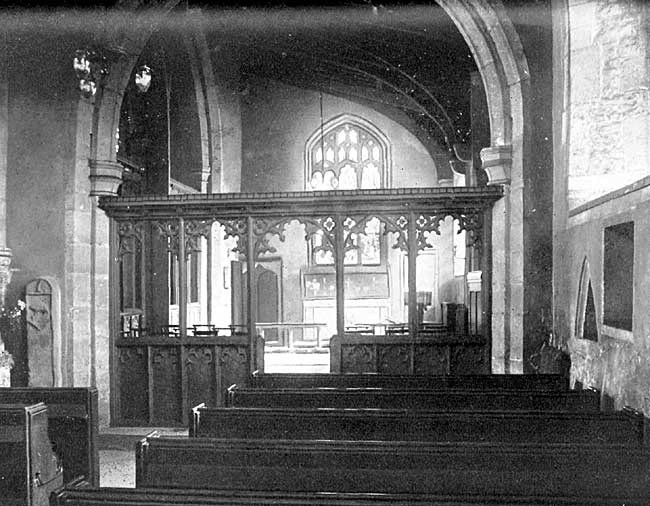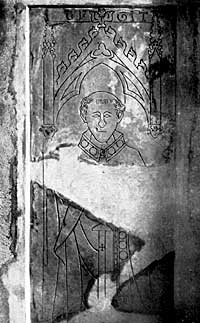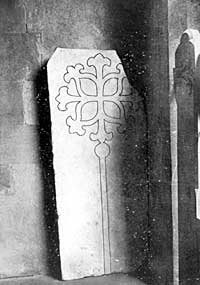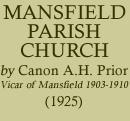< Previous | Contents | Next >
Monuments, Tablets, etc., within the Church.

PLATE VI. South Chapel, showing Squint, Ogee Arch, Incised Tombstone, Ambry and Piscina of S. Lawrence Altar and James Badger's Tombstone.
When we recollect that the Stanhopes (V), Pierreponts (W), Molineux (X), and perhaps the Herizs (Y) and Darcies, all had town houses in Mansfield, there is for so venerable a Church, in such a locality, a singular lack of monuments. That this was not always the case, and that there must at some period have been a wholesale mutilation, is clear from a note in the Harleian MS. (Z), and from the coats of arms which Harrod saw in the windows in 1800.
In the thick Norman wall dividing the chancel from the South chapel there is an interesting SQUINT or "low side window." It is partly constructed of a slab which bears the emblems of a master mason (Plate VIII.). The mediaeval masons had no compunction in so utilising gravestones. The old theory that these squints were leper windows, is now exploded, and the fact that before the chapels were added this must have been an outer wall, together with its peculiar construction, lends weight to the suggestion that herein may have burnt at night a light to scare away evil spirits.
It must, however, remain an open question as to whether the squint was constructed before or after the erection of the side chapel in the XV. century. The face of the Mason's slab bears no sign of weathering—it does not look as though it had stood much exposure. Perhaps it has never been a "low side" window at all, but a connection between the two Altars. It is a point not easy of solution.
A squint between the High Altar, and one situate in a side aisle, is comparatively common, but the position here is somewhat unusual.
In the north chapel lies an XI. century STONE COFFIN possibly originally used for the burial of one of the rectors presented by the Crown before 1100. An old inhabitant recollects the discovery of this coffin in the centre of the chancel at the restoration in 1871. (See also close to it a well preserved Ledger Stone.)
Against the East wall of the South chapel have recently been reared the pieced-together fragments of a slab. This once may have been the lid of the stone coffin, but Mr. S. John Hope says that during the reaction 1553-1558 it may possibly have been taken and used as a MARIAN ALTAR.

PLATE IX. Incised Slab of Priest, William de Beckhampton, 1372.

PLATE X. XIII. Century Incised Slab in South Porch.
This slab of a priest in vestments probably depicts, and very beautifully too, (A), William de Beckhampton, who died 1372. He was one of the few Vicars of Mansfield who died as such. He would have rights of burial in the chancel, and may possibly have been laid in the coffin of a predecessor.
The Greek dedication cross in the centre of the figure, and the wilful mutilation of the slab, lend weight to the theory that this was once a Marian Altar, improvised from an old floor slab. During the short period of the Marian reaction stone altars were replaced, but in 1560 Elizabeth ordered wooden Communion Tables to be set up, and the Churchwardens were compelled to sign declarations on oath that the stone ones were destroyed (B).
Considering the fact that the incised XIII. century slabs now in the porches and by the High Altar remain intact, we uphold the theory that our mutilated slab is the work of the Elizabethan iconoclasts, and must have been destroyed solely because for a short period it had served as a Marian Altar. The two words that are legible on the stone tell us the inscription was in Norman French (C) ICY GIT—Hic jacet—Here lies. Norman French was in use from 1100-1370.
What now serves as the CREDENCE TABLE for the side chapel is constructed out of the panels of the old Jacobean Altar, which, together with the two small chairs, stood within the little semi-circular rail for the first half of the XIX. century. This Altar may be of the age of Elizabeth; it may be the one which replaced the wrecked Marian Altar, for the form of veneering is very rare, the veneers being in reality thin boards commonly called facings.
The Altar in the South Chapel is constructed of oak taken from a beam dislodged when the Organ Chamber was built in 1903.
Immediately above this is the FIRTH TABLET, which Harrod noticed in the centre aisle (D) above the spot where probably this "Vicar of Bray" was buried.
AEternae Memoria
Johannis Firth STB
Hujus Ecclesiae plusquam 45
Annos Vicary concionatoris
praeclari assidui viri inter
primos docti eruditi qui cum Domino diu vigilasset
Senio confectus tandem
fractus in Christo obdormavit
25 die May
Anno Dni. 1699
Etatis sua 74.
Translation—
To the Eternal Memory of
John Firth, B.D.,
of this Church for more than 45 years
Vicar and Concionator (E)
a man of high distinction
and constant activity
Second to none in learning and erudition
Who after long watching for the Lord
worn out with age and at last broken down
fell asleep in Christ
25th May 1699
In the 74th year of his age.
When Charles I.'s head rolled on the scaffold at Whitehall more than a man's life came to an end. The old order of things passed away, a new order of men crept into the benefices left vacant by the ejected clergy. The Church was reinstated at the Restoration, but there were many things which no Restoration could restore. Firth appears to have been a man of the new order. The inscription on the tablet would make his vicariate commence in 1654, five years after the execution of Charles, but in the marriage register of 1657 he was styled "Public minister."
We have been quite unable to discover what became of his predecessor, John Price, who a year after his induction in 1628 had married at Leicester, Isabell, the daughter of Roland Dand, of Woodhouse, the trustee of the Intake. Price does not figure among Walker's ejected clergy, but he disappears from the registers (which he scrupulously kept) in 1641, three years before the Prayer Book was suppressed. Of course he may have died, but of his burial there is no record. He may have retired to Leicester or Woodhouse; he may be the Mr. Price whose name figures on the Woodhouse Charity Board. What took place between 1641-1654 is a dark page in the history of most parishes. No doubt the axes and hammers were busy at work, tombs were demolished, stained glass smashed, office books burnt, much sacrilege committed. A Public Registrar was appointed for each parish by Act of Parliament under the Commonwealth, but his work here, as in most other parishes, was inefficiently performed. At the Restoration in 1660 Firth found himself far too comfortable in Mansfield to run the risk of ejection on Black Bartholomew. He adapted his conscience and his convictions to the times; reintroduced the Prayer Book (revised by his townsman, Richard Sterne), gladly accepted the gift of a stone font (F) and altar cloth from his churchwarden, Francis Molyneux (G), exhibited his zeal for the Church, which a few years before he would have done little to save, by collecting money to crown the tower with a steeple, superintended the public whippings at the Ratcliff Gate Cross (H), and lived on well-nigh to see Queen Anne ascend the throne of her murdered grandfather.
The RISHTON TABLET escaped the attention of Harrod —it is now placed on the wall of the South Aisle, and is solely interesting, inasmuch as there is inscribed on it a somewhat free quotation from the Bishop's Bible.
Here lyeth Francis ye wife of Theophilus
Rishton of Mansfeild in Sherwood in ye county
of Nottingha Yeoman Daughtr of William
Readman of Southmusker in ye same county
who died ye XXIX. of Decembr 1629.
I know that my Redeemer liveth & that I
shall rise out of ye Earth in ye last day
& shall be covered againe with my skinne &
shall see God in my flesh. Job 19.
Memento Mori.
The Authorised Version had been in existence 18 years, when this tablet was erected, but apparently had not yet found its way to Mansfield. In 1702 Bishop Nicholson, in his Carlisle Visitation, complains grievously that so few Churches had provided themselves with an Authorised Version. It would seem that the Authorised Version, nearly 300 years ago, was as slow in making its way into favour as the Revised Version is to-day. Perhaps the Bible given by Francis Molyneux in 1662, and which, alas! was destroyed a few years ago, was the first Authorised Version possessed by Mansfield Parish Church.
For an account of the MOLYNEUX family we must travel to Teversall and inspect there the monuments on the walls, the cross on the West wall of the tower, and the canopied pew. The brass which is now placed near our Font is probably a coffin plate, and was found in a crumpled condition in 1904, underneath the stone coffin in the North chapel.
Hic jacet Franciscus Molyneux filius
Natu Minor Domini Francisci Molyneux
De Tevers-Hall, Baronetti
qui in uxorem duxit Graciam
Filiam Praenobilis Conyers Darcy
Domini Darcy
Meynell et Conyers
Et obiit die Februarie sexto
Anno Domini
MDCLXVI.
This Francis, who according to the Teversal registers, was born in 1626, lived probably at the Molyneux House in West Gate. He was Churchwarden (G) in the time of the Commonwealth, with Robert Brunts, and it is perhaps due to him that the Registers were kept as well as they were. At the Restoration, as we have previously noted, he gave a Bible (published 1659), bound in leather; a Cloth for the Communion Table (probably the very table doing duty for a Credence in the South Chapel), a Pulpit Flanging, and the Font, which bears date 1661 (F). His son Darcy, who was one of the signatories of Firth's agreement in 1682, was baptised 3rd August, 1652, and his grandson 10th August, 1696—but Lady Carnarvon can give us no information as to the history of this junior branch of the Molyneux family.
The LAYCOCK TABLET, much defaced, bears a Latin inscription:—
Effare Marmor
Quales tu cineres subtus heic tenes reconditos
Cineres Gualteri Laycock
Haud vulgari fama medici
Filii natu maximi Gualteri Laycock
Nuper de Egmanton-hall, armigeri
Effare
Quantum valuit animi dotibus,
Quantum oris suavitate;
AEque amans omnium ac amatus omnibus
Quntum artis suce Virtute, excoluit
Dum apud nos virginti circiter annos medicinam
Feliciterque adornavit
Quantum deniq charitate
Pauperes sublevando dum vivus medicus
Vestiendo moribundus
Centum libris huic usui testamento dicatis
In AEternum suae beneficientae
Memoriam.
Obiit anno aetatis suoe 50,
Dno Anno Salutis, 1701, May, die 22.
Translation—
Tell, O Marble,
What honoured ashes thou holdest buried beneath this spot.
The ashes of Walter Laycock,
A physician of no common reputation,
Eldest son of Walter Laycock,
Formerly of Egmanton Hall, Esquire.
Tell
How rich he was in mental endowments,
How rich in pleasantness of speech,
Equally a lover of all men and by all men beloved,
While for about twenty years he practised and
Happily adorned medicine.
Lastly how rich in charity,
Relieving the poor while he was a living physician,
And on his death bed clothing them,
Having by his will set apart a hundred pounds for this
purpose (I)
For an eternal memorial of his beneficence.
He died in the fiftieth year of his age,
On the 22nd day of May in the year of Grace, 1701.
Close by the Font is the bricked-up Doorway, which tradition in the Parish has always called the ALE DOOR.
It is a relic not often met with to-day, and speaks of customs now happily extinct. "Church Ales" flourished about the time of Henry VIII. There is a dim notion that they were rather disreputable feasts, in which under pretence of honouring some saint, people over-indulged in drink. As a matter of fact, they were the prototype of bazaars and charity balls, the object being to get money for the Church expenses before the days of Church Rates. The feast usually was held at Whitsuntide, and organised by the Churchwardens, "who provided a good spread at so much a head, and credited the profits to the Church expenditure." In some cases the banquet seems to have been held in the Churchyard. That Churchyards in the XIII. and XIV. centuries, aye, and later, were scandalously secularised is of course notorious; in our case the ale seems to have stood in barrels in the Church, and been retailed at the Ale Door. A profit was frequently made, which to-day would be equivalent to £80 to £100.
Church Ales continued until the Civil War broke out, when the feasting and drinking were removed to a neighbouring Tavern. The Elm Tree, across the water, seems to have been in high favour in 1698, and may have been the residuary legatee of the Mansfield Church Ales.
At the Restoration in 1870 the mural tablets seem to have been collected from all parts of the Church and stored under the Tower. Most have been now replaced in their original position.
Skied up immediately under the Belfry floor, is one bearing a coat of arms. The inscription is worth reproducing:—
Here under lieth the Body of
Wendesley Blackwall, of Dethick, in the County of Derby,
Esquire,
Who was aged about 54 yeares, and died March the 30th, being
Palmesunday, Anno Domini 1634.
Wenslaus jacet his Blackwallus marmore clausus :
Includit marmor corpora, non animas. Altera pars terram petiit, petit altera caelum :
Qui vixit Moriens, morte perrennis erit. Quern mors per quatuor nunc expugnaverat annos,
Is mortem subito nunc moriendo fugit. Conjuge dilecta, numerosa prole, beatum,
Caelesti afflatu, dotibus, ingenii, Invidus hunc Daemon varie tentavit Iobum,
Mente premems fessum, corpore mox crucians. Tandem, cum morbi, mortis, cum Daemonis iram Transierat
patiens, victor ad astra redit.
—See Lyson's Derbyshire, CXVIII.
Translation—
Here lies Wendesley Blackwall, enclosed in marble; but marble incloses the body, not the soul. One part of him hath come to the earth, the other goes to heaven. He who in this life died daily, shall by death gain immortality. He whom death for these four years had assaulted, now in a moment by dying escapes from death. Blest with a beloved wife and a numerous family, with the inspiration of heaven and the dower of natural abilities—this second Job did the envious Devil tempt in divers ways, oppressing him mentally when he was weary, and sometimes torturing him in body. At length, after patiently passing through the wrath of disease, death, and the Devil, he returns victorious to the skies.
The family of Clay in times back seems to have been a numerous and influential one. A John Clay, of Mansfield, married Anne Hall, of Kettlethorpe (the latter was the grandchild of George Mompesson), and from this union sprang the Clays of Calverton, and the Housons of Southwell. The subscribed inscription on a brass in our Church is worth recording:—
Jonathan Clay,
de hac Villa,
Attornatus
Obt. 16, Kal. Jul. A.D. MDCCXXIV.
AEtat, 39
Vixit amicis & Vicinise Utilitati parum diu
Sibimet ipsi et Famae suae satis.
Trans.
For his friends and the neighbourhood (so great was his usefulness) he lived too short a time.
For himself and the acquisition of fame he lived long enough.
Not far from this is a Tablet curiously characteristic of the times :—
MS.
In sure and certain hope of a joyful resurrection here rests
The Ashes of Margaret, only daughter of (X)
the Rev. Mr. Ellis, Rector of Kirkby,
and wife of Joseph Meymott, late of Mansfield, Mercer.
Remarkable in that she departed this life
On the same day in which her beloved
And justly admired Sovereign Queen Ann,
Of pious memory,
Changed her earthly crown
For a more exceeding weight of glory,
which was August 1, 1714.
Joseph Meymott was buried in Halifax Church March, 1717.
On the South wall of the Tower is a small brass to the memory of WILLIAM STERNE, Gent. He would be probably the Mr. Sterne who gave £3 to the rebuilding of the Grammar School in the reign of Queen Anne (J), and of the same family as Mansfield's only worthy. Archbishop Sterne (K), and Lawrence Sterne, the humourist. The Sterne's house was in Ratcliffe Gate, possibly Lime Tree Place (see Manor Rolls).
(V) The old family house of the Earls of Chesterfield, which stood where the Bridge Street Chapel now is, was sold to the Wesleyan Society in 1810, and entirely demolished 1864. The Stanhope burial place is at Shelford. Tradition says the illustrious Earl of Chesterfield was born at Mansfield in 1694. We can find no record of his birth. He died 1773. Dr. Dodd, the tutor to the 5th Earl of Chesterfield, was living here when he was arrested for forgery, and hung 1777.
(W) The "Good Earl of Kingston" (Burke Extinct Peerage, p. 419), who married Gertrude Talbot, and whose mother was the daughter of Bess of Hardwick, had three children baptised in the Church, but there is no tradition or record where the Pierrepont house stood. The "Good Earl" was killed by a canon ball, 1643, as he was attempting to escape the Parliamentarians by crossing the Trent at Gainsborough.
(X) The Molineux house stands in West Gate. It seems to have been the residence of the younger branch of the Teversal family, of which the Dowager Countess of Carnarvon is the present representative.
(Y) In the South Aisle East Window Harrod noted the arms of both the Heriz and Darcie families, p. 4. Sarah Heriz married a Sir Robert D'Arcy Conyers, Earl of Holderness.
(Z) Harleian MSS., vol. ii., 31. 1408. In 1408 Mansfield Church possessed Coats of Arms.
(A) Note the base of the Chalice : the Guardian Angels : the Maniple.
(B) English Church Furniture, Ornaments, and Decorations, 1566, in Lincolnshire Churches, Ed. Edward Peacock, 1866, p. 45 : "Item as for altar stones we had none in Queen Mary's time, but certain grave stones which we were fain to take up off our Church floor, and when the altars were taken down we paved them again."
(C) In the Letters Patent of King Philip and Queen Mary granting lands to the Vicar and Churchwardens in 1557—which document is in our possession—there is one sentence in Norman-French, and this must be one of the last instances of its use in England.
(D) Burial in the Nave involved a Fee to the Churchwardens towards Church Expenses. In the case of a burial in the Churchyard or Chancel the Fee went to the Incumbent.
(E) See page 45. Depositions in Church safe prove Price was Vicar for 20 years.
(F) This Font was lent in 1902 to Warsop Vale Mission Church, and is now in S. Lawrence's Church.
(G) See P. Register. Vol. II.
(H) See page 29.
(I) There is a Rent Charge of £5 on the Whinney Closes paid by the Duke of Portland annually for the purchase of 10 Petticoats yearly to be disposed of on the Feast of All Saints.
(x) Named after Margaret Newcastle. Clement Ellis was Chaplain at Welbeck 1661.
(J) Harrod, p. 27.
(K) See page 46.
